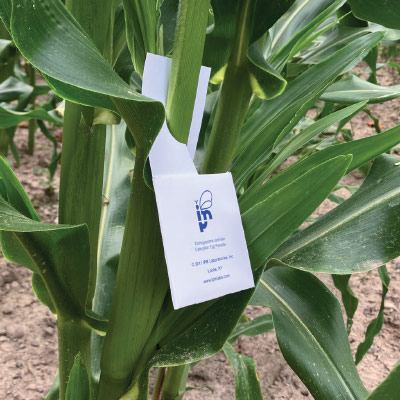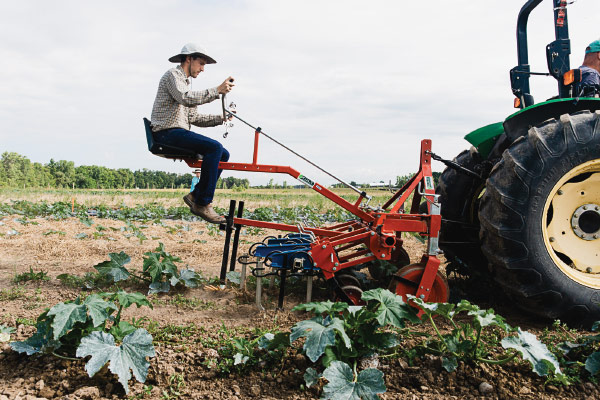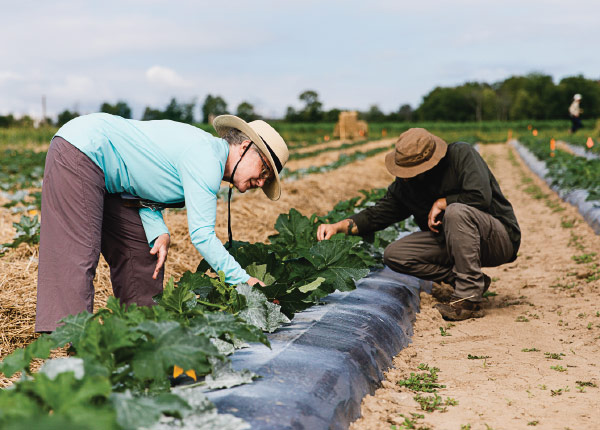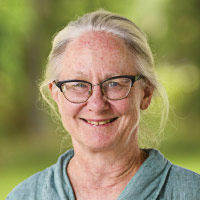Working at the Intersection of IPM and Organic
By Abby J. Seaman, Cornell Integrated Pest Management
Throughout my career with the New York State Integrated Pest Management Program, recently rebranded as Cornell IPM, I’ve been most interested in the cultural and biological control aspects of IPM—those basic and not-so-basic cultural practices that help reduce pest (insects, diseases, weeds) levels to minimize pesticide inputs. I always ask how we can use our understanding of pest biology to thwart their development and where could biological controls be incorporated into our pest management systems.
Where Did These Interests Come From and Where Did They Lead Me?
I’m pretty sure my family’s interest in gardening and subscription to Rodale’s Organic Gardening magazine started it all, as well as my mom’s conviction that I would attend Cornell. I eventually did, after starting as an environmental science major at SUNY Plattsburgh. After seeing a high school friend’s Cornell course roster (there’s an entire course on photosynthesis?!), I transferred to CALS as a junior. At that time, there was a major called plant protection, which enabled me to take courses across the spectrum of agricultural disciplines, including plant pathology, entomology, and weed science, as well as my first course in biological control. My post-undergraduate time working in insect pathology and tree fruit entomology research labs furthered my education and led me to team up with two brand new faculty members to work on biological control of grape berry moth for a master’s degree in entomology. My time working as a technician in an agroecology research lab introduced me to new concepts as well as a group of graduate students who met regularly to discuss how to foster support for sustainable and organic agriculture at CALS. During that time, I also started volunteering with the NOFA-NY’s Organic Certification Standards Board, helping to establish standards and review applications for certifying New York farms as organic.
This is the background I brought with me to NYSIPM in 1993. At that time, many people were still apprehensive about the concept of IPM. I still remember the look of dismay on the face of one grower who was struggling to control Colorado potato beetle (CPB) on his small-acreage diversified farm. At that time CPB was resistant to just about every insecticide that was labeled for its treatment. I suggested he rotate his solanaceous crops as a block to take advantage of the fact that when CPB emerge in the spring they aren’t able to fly, and the further you can rotate your crop away from last year’s crop, the longer it takes them to find it. Clearly, he was hoping I would pull a miraculous insecticide out of my pocket that no one else knew about! A few years later, I learned that large scale potato growers in Wyoming County were teaming together to swap land for distance rotations to control Colorado potato beetle. I wonder if the look on their faces was the same when this practice was first suggested to them.
With the help of supportive Cornell Cooperative Extension colleagues and CALS faculty, and the NYSIPM Small Grants Program, I spent my first years learning about and conducting on-farm demonstrations of basic IPM practices in a variety of vegetable crops. At the same time, I was being asked to present at organic farming conferences, where my approach to IPM aligned with the organic farming philosophy. I found an audience that was mistrustful of Cornell and feeling underserved by Cornell Cooperative Extension, but eager to share their challenges and work together to develop solutions. I found myself unable to provide solutions for some of the more challenging pest management problems in organic vegetable production and began to focus more on developing resources and collaborating with colleagues to research pest management solutions for organic vegetable farmers. Some of these projects are described below.
 |
|
Trichogramma ostriniae packet attached directly to a corn plant. Photo by Abby Seaman. |
Trichogramma ostriniae
A project that did not initially target organic producers was working with entomology professor Mike Hoffmann and his lab, researching and demonstrating releases of Trichogramma ostriniae to control European corn borer in sweet corn and peppers. The original intent of the releases was to reduce pesticide use in conventional systems, but organic growers showed much more interest than conventional growers. I and colleagues in other states worked mostly with organic growers on research and demonstration trials to establish effective release rates and timings. European corn borer has since disappeared as a pest for conventional growers, but persists on some farms growing organic sweet corn, where Trichogramma ostriniae is still used.
Organic Production and IPM Guides
One of the first projects I coordinated that was strictly focused on organic production was the development of organic production guides for several processing vegetables in response to industry interest in sourcing those products in New York. With support from the NYS Department of Agriculture and Markets, Cornell faculty and CCE colleagues collaborated to create guides for eight vegetable crops. Those are currently being updated and expanded to include additional crops.
 |
|
Removing weeds between rows of organic squash. Photo by Allison Usavage. |
Efficacy of Products Allowed for Organic Production
For a variety of reasons, some insects and diseases on organic farms are not adequately controlled by cultural practices and biocontrol options are not available. In these cases, pesticide solutions are needed. While there were products on the market, little was known about their efficacy, and little research was being conducted. For nine years, starting in 2009, I obtained funding and collaborated with now Cornell AgriTech director Chris Smart and professor Brian Nault to conduct trials evaluating the efficacy of products labeled for pests that growers most frequently identified as problematic including striped cucumber beetle, crucifer flea beetle, squash vine borer, squash bug, cucurbit powdery and downy mildew, and tomato foliar diseases. Since that funding ended, faculty colleagues have routinely included products allowed for organic production in their trials.
Organic Squash Systems Trial
 |
|
Abby Seaman in the field. Photo by Allison Usavage. |
Successful organic production involves developing systems of cultural practices for managing pests, and the system developed for one pest can influence other pests. Systems trials are the best way to examine these interactions. In 2000 and 2001, Bryan Brown, weed IPM specialist with Cornell IPM, and I collaborated with Chris Smart and Brian Nault on organic winter squash systems trials. We focused on four weed management systems, looking at their impacts on weeds, pest and beneficial insects, diseases, and profitability with and without the use of pesticide applied following IPM thresholds. The trial showed that the weed systems can have subtle impacts on pest and beneficial insects as well as diseases and that the cost of the IPM practices can be recouped in higher yield and quality in some systems.
So much has changed since I started with NYSIPM in 1993. IPM is now standard practice on most vegetable farms. Relationships and trust between organic vegetable farmers and Cornell are much stronger. Vegetable specialists with regional extension programs routinely work with organic farmers. One of the signature programs of the Northeastern IPM Center is IPM and Organic Systems, and its former director Carrie Koplinka-Loehr was instrumental in forming a national Organic and IPM Working Group to facilitate collaboration between organic and IPM communities.
Working with organic farmers has shown me how beneficial cultural practices and biological control can be to pest management, and when (and sometimes why) they aren’t enough. I consider organic farmers to be high-level IPM adopters. It’s challenging and there are sometimes failures, but what we learn by helping organic farmers successfully manage pests can also help conventional IPM practitioners reduce their environmental impact. Research that focuses on better understanding agroecosystems, enhancing ecosystem services, developing management solutions that don’t require conventional insecticides, and developing cropping systems based on this research will benefit all farmers, regardless of their production philosophy.

Abby Seaman, Associate Director of Agricultural IPM and the Vegetable IPM Coordinator, Cornell IPM, received an Outstanding Achievements in Integrated Pest Management Award from the Northeastern IPM Center in 2025. The annual award, launched in 2019, recognizes individuals or organizations whose work on IPM in the Northeast deserves special recognition.
